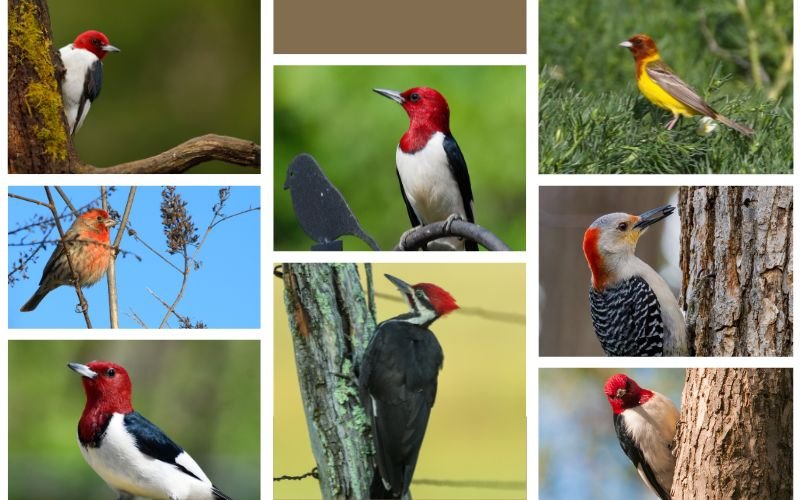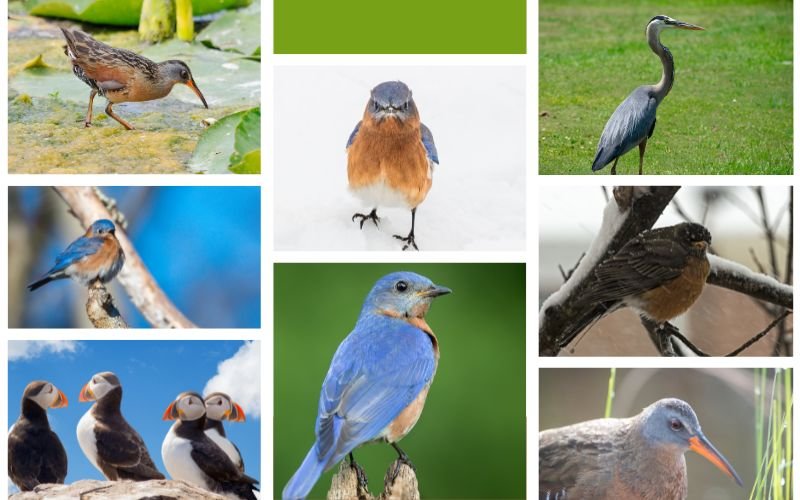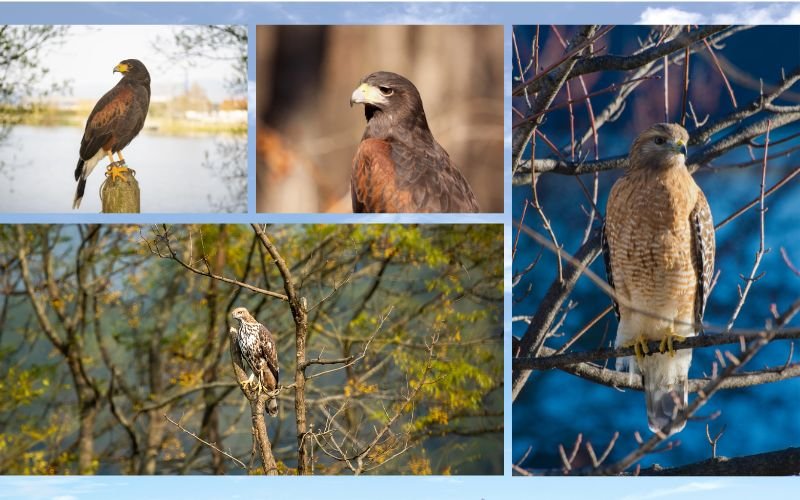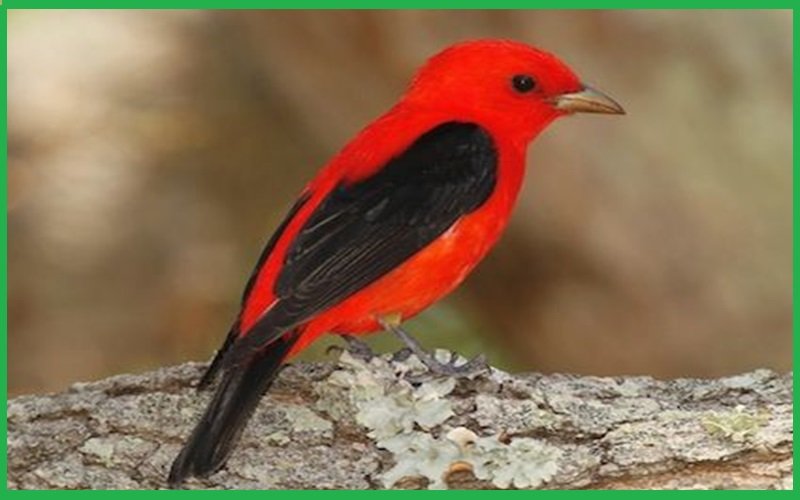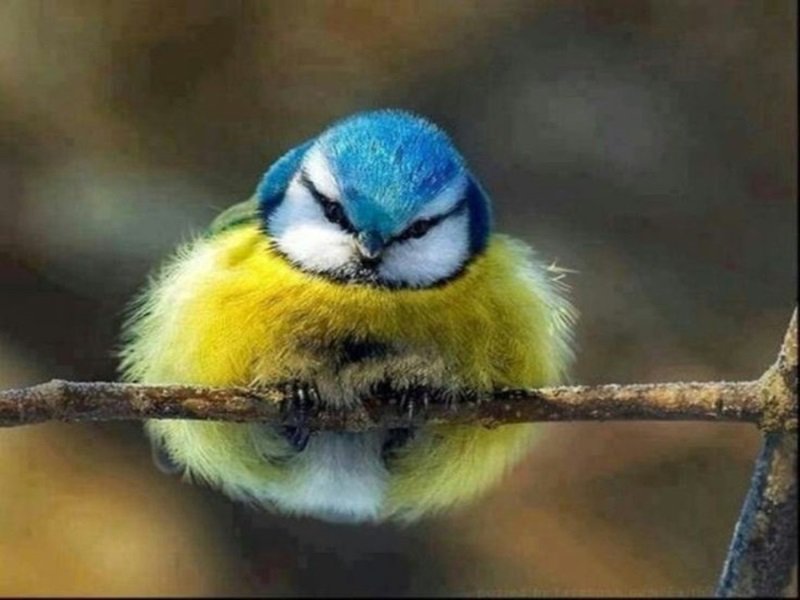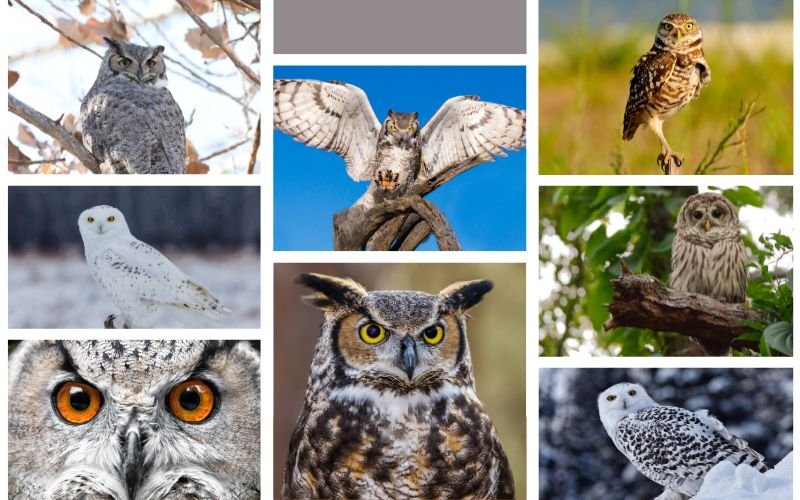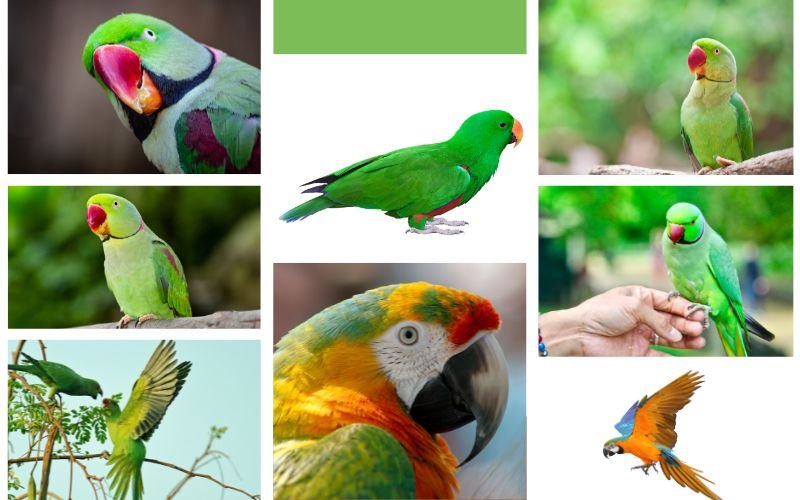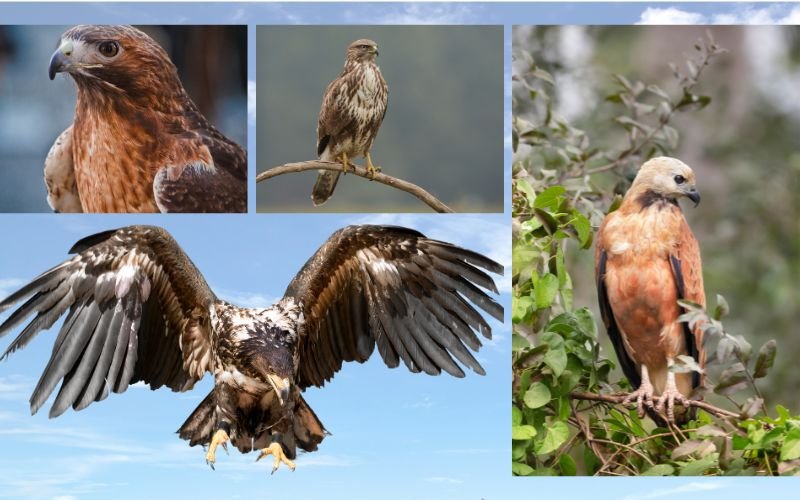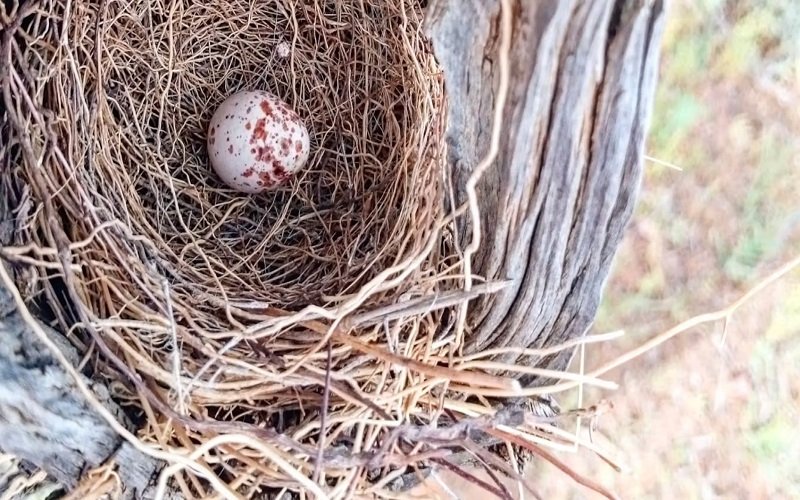Black and white birds with red heads represent diverse species collection and their contrasting plumage among avian species.
This contrast plumage over their body enhances their look and appearance, symbolizing their diversity.
This article will provide the top 17 black-and-white birds with redheads along with their scientific names, sizes, native places, lifespans, wingspans, and other facts in detail.
So let’s delve into their world of contrast plumage.
Top 17 Black and White Birds with Redheads
Black and white birds with redheads symbolize the beauty of having diverse plumage over their bodies.
Their looks and appearances vary from their own characteristics and have a genetic structure inherited from their ancestors.
This section will discuss the top 17 black-and-white birds with red, along with their physical description, characteristics, distribution, food, and other facts about them.
Bird 1: Red-bellied Woodpecker

- Scientific name: Melanerpes carolinus
- Lifespan: around 12 years
- Wingspan: 15 to 18 inches
- Native to: Eastern United States including Florida and Canada
- Size: 22.85 to 26.7 cm
- Food or Diet: beetles, centipedes, spiders, fruits, and other insects
The Red-Bellied woodpeckers are medium-sized, similar subspecies to the woodpecker family.
They are mostly familiar in the eastern United States, including South Florida and North Canada. Some might confuse them with red-headed woodpeckers; however, their red patch on the head, zebra patterns, and black and white stripes in the wings define their identity.
These birds are noisy and create lots of chur-chur-chur sounds, which shows that they are trying to call other groups or pairs to communicate.
Sometimes, they tap on hollow trees or aluminum roofs to make a sound. These woodpeckers can catch their prey or any other insects in flight positions.
These red-bellied woodpeckers prefer dead or dry wood for their nesting purposes. Male birds always seek the permission of their mates and tap their nesting holes mutually.
Bird 2: Red Crested Cardinal

- Scientific name: Paroaria coronata
- Lifespan: 3.8 years around
- Wingspan: 30.5 cm
- Native to: Pantanal, Northern Argentina, Bolivia, Paraguay, Uruguay
- Size: 22 to 23 cm
- Food or diet: fruits, insects, and insects
Red-crested cardinals are small songbirds of the tanager family. They are also known as Brazilian cardinals. These red-crested birds have redheads, crests, necks, and throats.
Their belly and lower underparts are white with black wings in the back. These red-crested birds are familiar in Brazil, Bolivia, Paraguay, Northern Argentina, and Uruguay.
They can also be familiar with Hawaii, Rico, and Chile countries. These red-crested cardinals prefer subtropical, tropical dry shrublands and heavily degraded forests for their habitats.
Their estimated flying range is around 500 meters (1600 ft) above the sea surface. They sometimes fly over rivers, marshes, and lakes as well.
Bird 3: Red-headed Woodpecker

- Scientific name: Melanerpes erythrocephalus
- Lifespan: maximum longevity of 9.9 years
- Wingspans: 16.7 inches
- Native to: North America
- Size: 19 to 25 cm
- Food or Diet: seeds, nuts, berries, fruits, insects, etc.
Red-headed woodpeckers are medium-sized woodpeckers. They have black backs and tails, white breasts and belly, bright red heads, and black beaks.
These species are mostly spotted in North America, including southern Canada and the East Central United States. These woodpeckers store their food in tree cavities, a habit only found in two to three species, including this redhead woodpecker.
They stuff food into their tree holes or cavities, which helps them survive throughout the years. These species remain with their partner for several breeding seasons. After building their nests these woodpeckers become territorial and try to protect their territory.
Sometimes, they also destroy other birds’ eggs and territories. Female birds choose their nesting cavity, and sometimes, males and females drill trees to make their own cavities.
However, most of the drilling is done by the male woodpeckers. Female woodpecker birds lay 4 to 7 white eggs and incubate them for 2 weeks, usually, at around 27 to 31 days after the young fledge from their nests.
Bird 4: Pine Grosbeak

- Scientific name: Pinicola enucleator
- Lifespan: around 9.8 years.
- Wingspan: 13 inches
- Native to: Northern Eurasia, North America, Canada the United States
- Size: 20 to 25.5 cm
- Food or diet: seeds, buds, berries, and insects
Pine grosbeaks are a similar species of the Finch family, related to the Fringillidae group. They have red and black plumage over their bodies, with redheads, faces, backs, and rumps.
Their wings and tails are black, and they have white wing bars and large beaks. These grosbeaks are native to Alaska, the United States, and Canada and inhabit wooded areas, coniferous forests, and western mountains.
In Europe and North America, these birds, including coniferous forests, are mainly spotted for their breeding procedures. Female birds make horizontal nests on a brochure or in a fork of a conifer tree.
They might migrate to the South to search for food if they lack food sources. These birds are also spotted in flocks apart from their nesting seasons.
Bird: 5: Hairy Woodpecker

- Scientific name: Leuconotopicus villosus
- Lifespan: at least 15 years in captivity
- Wingspan: 33 to 43 cm
- Native to: North America
- Size: 18 to 26 cm
- Food or Diet: seeds, nuts, berries, insects, larvae, beetles, ants, tree sap, caterpillars, etc.
The Hairy woodpecker is a medium-sized bird related to the woodpecker family. Adult Hairy woodpeckers have black plumage on their upper parts and white spots on their wings.
Their lower body parts are light whitish brown, and their long beaks are white. They also have white bars on their eyes and mouth area. Adult male hairy woodpeckers have red patches on the back of their heads.
These birds are widely spotted in North America, including the Bahamas, Canada, Costa Rica, El Salvador, Guatemala, Mexico, and the United States.
These species inhabit deciduous forests. Hairy woodpeckers forage on trees and catch insects for their food.
These species also prefer mountain areas and sometimes move to lower places. They are the least concerned species by IUCN because it has 9 million individual species.
Bird 6: Red-Breasted Sapsucker

- Scientific name: Sphyrapicus ruber
- Lifespan: around 4 to 5 years
- Wingspan: 37 to 40.6 cm
- Native to: North America
- Size: 20 to 22 cm
- Food or diet: insects, tree sap, and fruits
Red-breasted sapsuckers are medium-sized woodpeckers that are familiar in mostly North America. These birds have red heads and upper chests with a white lower belly and rump.
Red-breasted sapsuckers are native to North America, including southeast Alaska, British Columbia, the Pacific Coast Range, Washington, and California. Their backs are black, and their wings have white wing bars.
They are fond of forests that have one hemlock, douglas-fir, and woodlands for their habitats as well. Some species also prefer old-growth forest areas for their habitats.
They collect sap from the loving trees which is their primary diet. These birds make nests in cavities and mostly prefer dead trees and deciduous trees to create holes in.
However, they do not reuse their nest cavities; rather, they prefer creating new cavities every season. In the nests, the female red-breasted sapsucker lays 4 to 7 pure white eggs and incubates them.
Later both parents feed the young until they leave the nests.
Bird 7: Scarlet Myzomela

- Scientific name: Myzomela sanguinolenta
- Lifespan: around 10 years
- Wingspan: 18 cm
- Native to: Australia
- Size: 9 to 11 cm
- Food or Diet: flowers, nectars, insects beetles, bugs, caterpillars, and flies
Scarlet myzomela birds also refer to small passerine birds, such as the Scarlet honeyeater. These birds have long, downward-pointing beaks and dark brownish eyes.
They also have black wings with white bars on the wings along with redheads and white belly parts. These birds are local to Australia, including North Queensland and Mitchel Rivers.
They prefer forests and woodlands for their habitats. These birds are always spotted in pairs, small troops, or sometimes alone. Their breeding season generally remains from winter to summer around July or August to January.
Afterward, their nesting process begins around April and May. Their nest is almost 5 cm and female birds take 8 days to build the nests before laying the eggs.
Later the female birds incubate the eggs for 11 to 12 days until they hatch.
Bird 8: Red Siskin

- Scientific name: Spinus cucullatus
- Lifespan: 4.2 years
- Wingspan: not found
- Native to: South America
- Size: around 10 cm
- Food or Diet: seeds, fruits, and insects
Red siskin birds are small Endangered avian species. They have black and white plumage over their bodies, with a black head, orangish red breasts, and belly.
They also had black eyes and grayish beaks. Red siskin birds are highly spotted in South America, including Northern Colombia, Venezuela, Guyana, and Trinidad.
These species tend to prefer open country, either forest edges or land with trees and shrubs. Female siskins lay at least three greenish-white pale eggs and incubate them.
Here, the male bird’s singing is similar to that of goldfinch birds, which have a melody and tune. These species are already endangered because they are losing their habitats, and other environmental factors are also contributing to their extinction.
Bird 9: Flame-colored Tanager

- Scientific name: Piranga bidentata
- Lifespan: 2-3 years
- Wingspan: 12 inches
- Native to: Central America, Northern Panama, and the United States
- Size: 18 to 19 cm (7.1 to 7.5 in)
- Food or Diet: arthropods, berries, fruits, flying insects
Flame-colored or stripe-backed tanagers are small American songbirds related to the Cardinalidae family.
These tanager birds have reddish-orange plumage over their body with brown parts below the eye to the bill side. Their wings are dark brown with white stripes.
Female tanagers have olive-brown plumage over their bodies. They are native to Central America, northern Panama, Mexico, Guatemala, Costa Rica, and the United States.
These birds prefer montane forests and large trees, coffee plantations, gardens, woodlands, open oak, and pine-oak for their habitats.
They can also fly up to 800 m (2600ft) above treeline and 1200 m (3900 ft) higher in the Panama region. These birds build their nests in open cup-shaped places with fine grass.
Generally, their breeding season starts between April and May.
Bird 10: Red Capped Cardinals

- Scientific name: Paroaria gularis
- Lifespan: not found
- Wingspan: found
- Native to: South America
- Size: 16.6 cm
- Food or Diet: fruits, berries, rice, insects, etc.
Red-capped cardinals are a small species of the tanager family widely distributed in South America. These birds have red faces and heads with black eyes.
They have black wings and white lower parts. These cardinal birds are found in South America, including the Guianas, Venezuela, Colombia, Ecuador, Peru, Bolivia, and the Amazon Basin in Brazil.
These red-capped cardinals prefer open North Eastern Amazon River lowlands, choosing mangroves, semi-open areas, and nearly watery places for their habitats.
These birds are mostly found in wetlands and lightly wooded lands. Red-capped cardinals are always seen in pairs or in family groups.
Female birds build shallow open nests about 9 to 10 cm wider and 7 cm outside in the tree or some other protected place. Later, the female bird lays 2 to 3 eggs and incubates the eggs it hatches.
Bird 11: Red Faced Warbler

- Scientific name: Cardellina rubrifrons
- Lifespan: not found
- Wingspan: 8.3 inches (21 cm)
- Native to: Mexico, Arizona, New Mexico
- Size: around 14 cm
- Food or diet: caterpillars, flies, aphids, leafhoppers etc.
The red-faced warbler is related to the New World warbler species group. It has light gray plumage on its upper side and a white rump.
In addition, they have a bright red patch on their face, neck, and upper breast side, with a crown black patch on their head. These red-faced warblers are local to Mexico, Arizona, and New Mexico.
In the summertime, they are spotted in northern Mexico, including the states of Arizona and New Mexico. Later in the winter, they travel or migrate to southern Mexico and Central America, including EI Salvador, Guatemala, and Honduras.
Besides, they choose mountain forests with conifers and oak trees as their habitats. These conifers and oak trees grow to 2000 to 3000 m (6600- 9800 feet) above sea surface level.
Female birds build small cup nests with leaves, grass, and pine needles. They also hide their nests on the forest floor and bury or cover them in the ground with a shrub, log, and rock. The female red-faced warbler lays 3 to 5 white brown eggs with a white spot on them.
Later they incubate the eggs for up to 12 days until the eggs hatch.
Bird 12: Scarlet Tanager

- Scientific name: Piranga olivacea
- Lifespan: around 10-12 years
- Wingspan: around 25 to 30 cm
- Native to: Eastern North America, South America
- Size: around 16 to 19 cm
- Food or Diet: mainly insects, wasps, bees, ants, snails, worms and some fruits
Scarlet Tanager birds are similar subspecies of tanager birds, belonging to the Cardinalidae family. Adult male tanagers have deep red plumage and black on the wings which almost resemble northern cardinals and summer tanagers.
Female tanagers have olive-yellowish plumage with brownish wings. These summer tanager species inhabit deciduous forests, oak trees, parks, suburban areas, and cemeteries in the North American region.
They reach their breeding spot between May and early June. Female tanager birds reach their breeding spots several days later. Later, females build nests and lay four eggs in a light blue color.
After laying the eggs, female birds incubate the eggs for about 11 to 14 days. The young birds leave their nest by 9 to 12 days and can fly fully after being hatched.
Sometimes, they fly around to catch their prey, and they can even be spotted on the forest grounds or floor searching for food.
Bird: 13 Crimson-breasted Woodpecker

- Scientific name: Campephilus melanoleucos
- Lifespan: around 5.2 years
- Wingspan: not found
- Native to: Panama, Trinidad, South America
- Size: 33 to 36 cm
- Food or Diet: beetles, butterflies, moths, ants, larval, berries and seeds
The crimson-crested woodpeckers are related to the woodpecker family, which is also one of the largest woodpeckers in the range.
These woodpeckers have black wings and two white bars on the wings, which are connected from their mouth to their beaks. Their breasts are speckled with white and brown.
They also have black and red crests on their heads. These woodpeckers are widely distributed in Panama, Trinidad, South America, Chile, and Uruguay.
They tend to inhabit landscape areas, forests with rivers, lowlands, and open areas with tall tree plantations. Crimson-breasted woodpeckers breed from November to January in the Panama region.
Both male and female woodpeckers build their nests in cavities with their drumming skills. Later, both parents will participate equally in the incubation process.
Bird 14: Pileated Woodpecker

- Scientific name: Dryocopus pileatus
- Lifespan: up to 11 years
- Native to: North America
- Size: 40 to 49 cm
- Food or Diet: fruits, insects, beetles, berries, nuts, ants, spiders, snails, etc.
Pileated Woodpecker, medium size woodpecker mostly distributed in North America. They are also found in Canada, the eastern United States, and a few parts of the Pacific coast at different seasonal times.
Their preferred inhabitants are forest areas, heavily wooded parks, and brushy and shrubby areas. These species make a large hole by drilling a dead or dry tree with their beaks.
Even their drilling can divide a small tree in half. By April, male birds make holes in trees and attract their female mates. After that, male and female birds raise the young in the holes.
Females incubate for 12 to 16 days. After that, the egg hatches. The young take 25 to 30 days to fly and leave the nest.
When their young leave the nests, both birds leave the holes, and they will not use the holes in the coming years. They are not migratory birds, as they stay in their holes or cavities and protect their territories for all seasons.
Bird 15: Downy Woodpecker
- Scientific name: Dryobates pubescens
- Lifespan: around 1 to 2 years
- Wingspan: around 10 to 12 inches
- Native to: North America
- Size: around 14 to 18 cm
- Food or Diet: sunflower seeds, berries, millet, peanuts, and chunky peanut butter
Downy woodpeckers are also related to the woodpecker family, which are widely distributed in North America, including the United States, Canada, Southwest, and Northern tundra.
Adult males have black and white plumage over their bodies with a little red patch on the head. These birds primarily choose forests for their habitats, and females make nests in tree cavities.
These birds again resemble hairy woodpeckers; however, their beaks and the pattern of the black spots can differentiate these two birds.
These species of woodpecker use several vocalization sounds, including a pik call. Their beaks can also produce drumming sounds.
However, their drumming sounds are comparatively slower than those of the North American species.
Bird 16: Ladder-backed Woodpecker

- Scientific name: Dryobates scalaris
- Lifespan: not found
- Wingspan: around 13 inches
- Native to: North America
- Size: 16.5 to 19 cm
- Food or Diet: larvae, ants, caterpillars, insects, leaf worms, etc
Ladder-backed woodpecker birds are again similar species of woodpecker birds native to North America and also identified as North American woodpeckers.
These woodpeckers have mainly black and white plumage-like zebra patterns over their bodies, with red crests on their heads and strong bills. These Ladder-backed woodpeckers very much resembled Nuttall’s woodpeckers.
Their preferred geographic distribution is Southern California and Baja California in North America. They also build their nests in cavities just like other woodpeckers as well.
They choose tree trunks or large cacti for their cavities. Later, females incubate 2 to 7 plain white eggs in those cavities. Sometimes, male woodpeckers also incubate the eggs.
Bird 17: White-winged Tanager

- Scientific name: Piranga leucoptera
- Lifespan: not found
- Wingspan: not found
- Native to: Central America, Mexico, South America, and Bolivia
- Size: 13 cm (5.1 in)
- Food or Diet: fruits, berries, seeds and insects
White-winged tanagers are small songbirds related to the cardinal family. Both male and female tanagers have white bars on their wings.
Male tanagers have bright red heads and black faces, while females have olive-yellow planets on their bodies. These species are mostly native to Mexico, Central America, South America, Guatemala, Costa Rica, western Panama, and Bolivia.
Their preferred habitats are oak trees, montane forests, cloud forests, and mature secondary forests. Their estimated highest flying range is 2,130 to 6,890 ft above the Orinoco River.
This species has also been spotted flying around 600 to 2000 m ( 2000- 6600 ft) above the ground surface in Colombia, Ecuador, and Peru. Its prime food is seeds, but it also eats fruits and insects.
Female tanagers build cup-shaped nests and lay eggs there.
Conclusion
In conclusion, these 17 black-and-white birds with redheads are the symbol of avian beauty. Their charismatic beauty and appearance enhance their look and survival tactics through their physical characteristics, geographic distribution, diets, adaptability, and other attributes of nature.
Similarly, there are small red-headed birds, brown birds with white spots, and purple birds around the world. These birds represent diversity in the avian species through their characteristics and adaptability.

